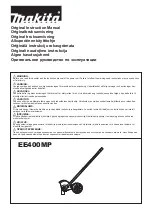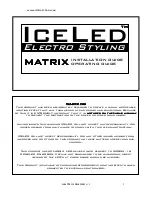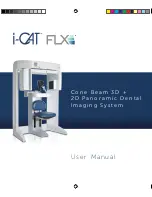
Millikan Oil Drop Apparatus
Historical Information
®
14
012-13093B
droplet formed around only one ion) proved to be only approximately correct, and the experimental methods were
not adequate to provide a precise determination of
e
.
H.S. Wilson improved upon Townsend’s and Thompson’s work by adding two brass plates which could be con-
nected to a 2000 volt battery. A cloud was formed between these plates (not charged) and the falling velocity of the
cloud recorded. A second cloud was then formed and its falling velocity observed in an electric field (the plates
being charged). Since the two velocities are proportional to the forces acting on the drops
2
, and the velocity of the
cloud with the plates uncharged determines the size and mass of the drops by Stokes’ Law, Wilson was able to
obtain a value of 3 x 10
-10
e.s.u. for
e
. Since Wilson’s measurements were always made on the top of the cloud, or
the drops with the smallest charge (the more heavily charged drops being driven downward faster in the field), the
assumption of one ion per drop was validated.
2
With the plates uncharged, the force is
mg
where
m
is the mass of the drop and
g
is the acceleration of gravity. With the plates
charged, the force is
mg
±
Ee
n
where
E
is the electric intensity between the plates and
e
n
is the charge on the drop.
Millikan’s Determination of
e
Millikan improved upon Wilson’s design by using a higher potential across the plates so that the falling velocity of
the cloud could not only be impeded, but actually reversed. Some charged drops moved upward, some moved rap-
idly downward, while the uncharged drops were unaffected and continued to drift downward. A few drops, which
carried a charge of the proper magnitude so that the force of gravity on the drop almost equaled the force of the
electric field on the drop, remained in view. By varying the potential of the plates, Millikan could just balance
these drops. This situation proved to be a significant improvement for it permitted all measurements to be made on
a single drop. By using this balanced drop method, Millikan was able to observe the properties of individual ions
and to determine whether different ions carry one and the same charge.
In the following passage, taken from the “Philosophical Magazine” for February, 1910, Millikan describes the
actual procedure of the experiment.
“The observations on the rate of fall were made with a short-focus telescope placed about 2 feet away from the
plates. In the eyepiece of this telescope were placed three equally spaced cross-hairs. . . . A small section of the
space between the plates was illuminated by a narrow beam from an arc light, the heat of the arc being absorbed by
three water cells in series. The air between the plates was ionized by 200 mg of radium of activity 20,000 placed
from 3 to 10 cm away from the plates. A second or so after
the cloud was produced
3
the radium was removed . . .
and the field thrown on by means a double-throw switch. If the drops were not found to be held suspended by the
field the
potential difference
was changed . . . . The cross-hairs were set near the lower plate, and as soon as a sta-
tionary drop was found somewhere above the upper cross-hair, it was watched for a few seconds to make sure that
it was not moving and then the field was thrown off and the plates short-circuited by means of the double-throw
switch, so as to make sure that they retained no charge. The drop was then timed by means of an accurate stop
watch as it passed across the three cross-hairs, one of the two hands of the watch being stopped at the instant of
passage across the middle cross-hair, and the other at the instant of passage across the lower one. It will be seen
that this method of observation furnishes a double check upon evaporation; for if the drop is stationary at first, it is
not evaporating sufficiently to influence the reading of the rate of fall, and if it begins to evaporate appreciably
before the reading is completed, the time required to pass through the second space should be greater than that
required to pass through the first space. It will be seen from the observations which follow that this was not, in
general, the case.
It is an exceedingly interesting and instructive experiment to watch one of these drops start and stop, or even
reverse its direction of motion, as the field is thrown off and on. I have often caught a drop which was just too light
to remain stationary and moved it back and forth in this way four or five times between the same two cross-hairs,
watching it first fall under gravity when the field was thrown off and then rise against gravity when the field was
thrown on . . . .
Furthermore, since the observations . . . are all made upon the same drop, all uncertainties as to whether conditions
can be exactly duplicated in the formation of successive clouds obviously disappear. There is no theoretical uncer-
tainty whatever left in the method unless it be an uncertainty as to whether or not Stokes’ Law applies to the rate of
fall of these drops under gravity.”
3
The italicized phrases indicate a slight change in wording, for purposes of clarity, from Millikan’s original work.







































